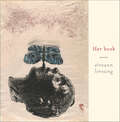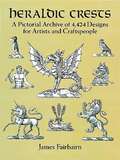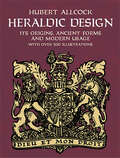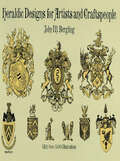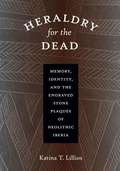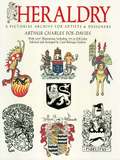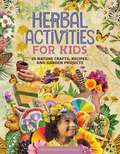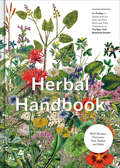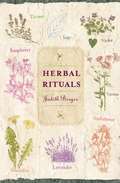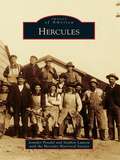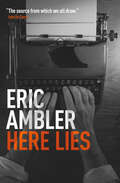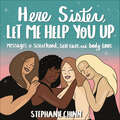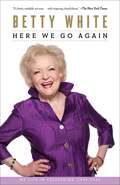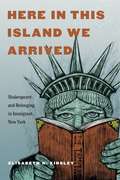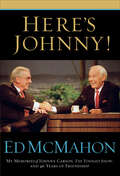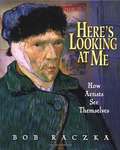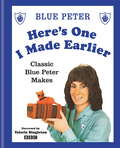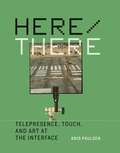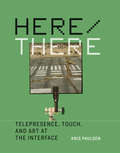- Table View
- List View
Her book: Poems
by Éireann Lorsung&“Exacting, and at the same time utterly magical." —ADA LIMÓNWith intelligence and crystalline clarity, a chorus of female voices speaks through the poems in Her book, Éireann Lorsung&’s luminous second collection.Full of youth, wonder, and imagination, Her book crosses distances and generations to celebrate the lives of women, their individual and shared experiences, and the bonds that bring them together. This is also a book about translation (of experience into art, of knowledge across time and space), conversation (with, for instance, work by the artist Kiki Smith), and friendship (especially those made during Lorsung&’s time in England). In these poems, the female body rises from a foundation of stars. Songbirds are cut from paper and stormy light. And letters arrive, and disappear, mysteries contained within.&“Part ecstatic recollection of the many ways places and objects leave their indelible marks upon our bodies and brains, and part timeless ode to the strange female beast that pounds inside of us all&” (Ada Limón), Her book is both an inspired work from Lorsung and, fundamentally, her book—poems belonging to all women.
Heraldic Crests: A Pictorial Archive of 4,424 Designs for Artists and Craftspeople (Dover Pictorial Archive)
by James FairbairnRich selection of royalty-free motifs from famous British reference. Striking, varied designs suitable for any number of graphic projects. Images include lions, tigers, wreaths, falcons, rosettes, human figures, mythical creatures, crowns, and much more. Add aristocratic flair to book and magazine illustrations, advertisements, newsletters, etc.
Heraldic Design: Its Origins, Ancient Forms and Modern Usage
by Hubert AllcockThrough the ages, as warfare and competitive rituals became more elaborate, heraldry evolved into an exact art and science. Used to denote accomplishments as well as the genealogies of outstanding individuals and families, these symbols survived the way of life that created them.This remarkably rich sourcebook of royalty-free designs describes the origins and ancient forms of heraldic devices, shields, and trademarks. Over 500 black-and-white drawings trace the history and meaning of the coat, shield, crests, helmets, blazonry, and "attitudes and attributes" of symbols, with considerable attention given to devices such as beasts, monsters, and human and part-human figures. American, British, French, Russian, and other coats of arms are displayed, as are insignias of the Pope and clergy, state seals, and emblems of many modern institutions. In addition to personal, commercial, and family arms, chapters also provide information on the use of heraldry in advertising, brand-labeling, and related fields.A valuable visual reference for anyone interested in genealogy, these handsome images will add a touch of class to a variety of art and craft projects.
Heraldic Designs for Artists and Craftspeople (Dover Pictorial Archive)
by J. M. BerglingOver 1,400 heraldic designs depicting shields, coats-of-arms, seals, logos, flags, insignia, scrolls, mottoes, and many other motifs will add a touch of medieval flair or aristocratic ambience to almost any graphic project. Use royalty-free or as a source of design inspiration for an infinite number of print projects.
Heraldry for the Dead
by Katina T. LilliosIn the late 1800s, archaeologists began discovering engraved stone plaques in Neolithic (3500-2500 BC) graves in southwestern Portugal and Spain. About the size of a palm, usually made of slate, and incised with geometric or, more rarely, zoomorphic and anthropomorphic designs, these plaques have mystified generations of researchers. What do their symbols signify? How were the plaques produced? Were they worn during an individual's lifetime, or only made at the time of their death? Why, indeed, were the plaques made at all? Employing an eclectic range of theoretical and methodological lenses, Katina Lillios surveys all that is currently known about the Iberian engraved stone plaques and advances her own carefully considered hypotheses about their manufacture and meanings. After analyzing data on the plaques' workmanship and distribution, she builds a convincing case that the majority of the Iberian plaques were genealogical records of the dead that served as durable markers of regional and local group identities. Such records, she argues, would have contributed toward legitimating and perpetuating an ideology of inherited social difference in the Iberian Late Neolithic.
Heraldry: A Pictorial Archive for Artists and Designers (Dover Pictorial Archive)
by Arthur Charles Fox-DaviesRoyalty-free treasury of 393 full-color, 654 black-and-white illustrations. Authentic heraldic arms, lions, eagles, dragons, shields, crests, windows, etc. Also, arms of cities and towns, arms of Edward the Black Prince, Milton, Maximilian I, others. Add aristocratic flair, noble bearing to almost any graphic project. Publisher's Note. Captions.
Herbal Activities for Kids: 50 Nature Crafts, Recipes, and Garden Projects
by Molly Meehan BrownA rich, colorful compendium of crafts, cooking, gardening, and nature exploration activities introduces kids ages 7 and up to the versatility and creative fun of working and playing with herbs. From dandelions to lavender, chamomile, turmeric, and lemon balm, herbs include a wonderfully diverse range of plants for crafting, cooking, and gardening. Kids will love exploring the world of herbs with this lively and colorful collection of 50 nature-based activities created by Molly Meehan Brown and the global community of herbalists who contribute to the Wild Ginger Community Herbal Center. Filled with photos and the whimsical art of Madison Safer, this eclectic and colorful compilation volume features easy-to-follow projects that engage all five senses. Includes activities for different ages and interests such as: How to make a pressed flower and herb collage Tie-dye fabric with turmeric Make elderberry syrup Plant a pollinator garden Make wild berry crumble Craft an herbal wreath or a flower bracelet Write a nature haiku Make lemon balm lip balm, and more! With bits of lore about herbs and herbalism sprinkled throughout, this is the perfect introduction to the versatility and usefulness of herbs for kids ages 7 and up.
Herbal Adventures: Backyard Excursions and Kitchen Creations for Kids and Their Families
by Rachel Jepson WolfDiscover the flavors and uses of common wild plants with this herbalist guide featuring recipes and tips on foraging right outside your door.When we think of wild plants with medicinal or culinary benefits, we typically think of something exotic and obscure. But many of the plants growing in our own neighborhoods can be just as useful and tasty as anything sold in a health food store. In Herbal Adventures, herbalist Rachel Wolf reveals the properties and uses of ten common plants—including chickweeds, dandelions, catnip and others.With the tips and recipes in this book, you can enjoy delicious homemade soda, flower petal pancakes, chickweed pesto, or your own herbal tea. Plus you'll be able to make a soothing balm for cuts and scrapes, syrup to quiet your cough, a rejuvenating herbal hair rinse, and much more! "A real gem . . . a perfect beginners' book no matter your age." —Rosemary Gladstar
Herbal Handbook: 50 Profiles in Words and Art from the Rare Book Collections of The New York Botanical Garden (New York Botanical Garden)
by The New York Botanical GardenA charming, information-packed guide to 51 herbs and their uses illustrated with rare botanical art from the renowned archives of The New York Botanical Garden.Did you know that woodruff was used as a room freshener in the Middle Ages; that crushed bergamot leaves can soothe bee stings; and that dried fenugreek seeds were found in the tomb of King Tutankhamen?Herbs are magical, and their uses myriad. Inside this informative, colorful handbook are fifty-one herbs portrayed in words and rare botanical art curated by experts at The New York Botanical Garden. Some, like saffron, are treasured and rare; others, like purslane, grow by the roadside. They all have a place—in the garden, in the kitchen, in the bed or the bath. Explore their history, how to grow them, and how they were used in the past and present. Then bring them into your daily life; each herb&’s profile offers a recipe or project that highlights its unique properties.So cleanse your face with calendula when you wake up, sip a bergamot tea at breakfast, have a lovage tuna sandwich for lunch, and mix a caraway cocktail at the end of the day. Let these herbs delight your senses as they have done to others for thousands of years.
Herbal Rituals
by Judith BergerHerbal Rituals is about connecting with Nature and the plant world in order to keep us near to the ground of our own souls. The book records, month by month, a yearlong journey in to the earth's natural cycle. Each monthly section describes a facet of the earth's temperament, offering us an opportunity to immerse ourselves in Nature's unique expression of birth, growth, fruition, decay, death and regeneration, the primary cycle that weaves a thread of continuance through our lives. Even in an urban environment, the constant presence of the elemental natural world and the use of herbs can be a touchstone to bring both body and soul back to a natural cadence. Each monthly chapter discusses one herb in detail - what it's like, how it grows, what it does - as well as presenting recipes for teas, lotions and foods, along with rituals appropriate to the season that can bring your life into harmony with the moods of nature. For thousands of years, humans have used herbs and trees for just this kind of medicine, in addition to calling on the plants as a source of nutrition, remedy, heating, shelter and magic. These are the old ways.
Hercules
by Stephen Lawton Jennifer Posedel Hercules Historical SocietyThe history of explosives manufacturing in Hercules began in 1879, when the California Powder Works acquired a site on San Pablo Bay, 20 miles northeast of San Francisco. The powder works, subsequently owned by Dupont and the Hercules Powder Company, produced one of the first internationally branded products: Hercules dynamite. It became the world's leading producer of TNT during World War I. The town of Hercules was incorporated in 1900, and for nearly 75 years its population remained under 300. The company-owned village had no retail district, but its employee clubhouse was the anchor for the city's social life. After the explosives plant closed, buildings comprising a small historic district were restored, while a diverse residential suburb grew rapidly around it. Hercules chronicles the city's industrial past and a vanishing way of life.
Hercules: I Made Herc a Hero by Phil
by Gabrielle CharbonnetHades had been trying to knock Herc off, see, so that he wouldn't get in the way when Hades made his move to take over Mount Olympus.
Here Down on Dark Earth: Loss and Remembrance in New York City
by Larry RacioppoDiscover New York’s poignant memorials through powerful photographs capturing everything from fleeting tributes to enduring monumentsThe photographs in Here Down on Dark Earth document the many ways New Yorkers express their intertwined feelings of loss and remembrance. The famous and the unknown, the rich and the poor, meet the same fate, but how they are mourned and remembered varies greatly. New York City’s monuments and memorials are large and small, civic and personal, traditional and vernacular, planned and spontaneous. Some commemorate a significant event such as the terrorist attack on the World Trade Center, others the death of a single child hit by a stray bullet. A memorial of stone and steel dedicated to deceased WWII veterans from a church parish may outlast a painted Rest-In-Peace (RIP) memorial wall for a slain teenager. Still, both grow out of the feeling of loss and a desire to preserve the memory of departed loved ones.As Racioppo traveled throughout New York City, he became increasingly aware of the impermanence of these memorials. The paint eventually peels, and the image gradually disappears. Sanitation workers remove the rotted toys and flowers. Small and personal, or large and communal, created by professionals or amateurs, the memorials in Here Down on Dark Earth express a powerful sense of loss and connection. Throughout the book, the author’s contextual notes accompany the poignant photographs depicting these expressions of remembrance.
Here Kitty Kitty
by Mallory McInnisThis charming book of whimsical illustrations is sure to win over even the most finicky cat lover. Brimming with colorful contemporary artwork by today's up-and-coming indie art and illustration darlings, and sprinkled throughout with quotations from famous folks celebrating the traits and quirks of their favorite furry friends, this fanciful and playful little volume offers kittenish delight on every page—making it the perfect ebook for cat lovers everywhere. Featuring dancing cats, snarky cats, musical cats, sleepy cats, cunning cats, cranky cats, cuddly cats, and dapper cats, there's a kitty for everyone in this treasury of heartwarming feline fun.
Here Kitty Kitty
by Mallory McInnisA cat-tastic collection of quirky illustrations and amusing quotes that capture the delightful (yet sometimes peculiar) realities of feline friendship. This charming book of whimsical illustrations is sure to win over even the most finicky cat lover. Brimming with colorful contemporary artwork by today&’s up-and-coming indie art and illustration darlings, and sprinkled throughout with quotations from famous folks celebrating the traits and quirks of their favorite furry friends, this fanciful and playful little volume offers kittenish delight on every page—making it the perfect just-because gift for cat lovers everywhere. Featuring dancing cats, snarky cats, musical cats, sleepy cats, cunning cats, cranky cats, cuddly cats, and dapper cats, there&’s a kitty for everyone in this treasury of heartwarming feline fun.
Here Lies: An Autobiography
by Eric AmblerIn his Edgar Award–winning autobiography, the “father of the modern crime thriller” reveals the eventful life that inspired his classic works (CrimeReads).Eric Ambler’s Here Lies invites readers inside the mind of one of the twentieth century’s greatest thriller writers. In this work the famously recalcitrant author peels back the layers of experience that affected his life with the same skill he uses to unfold the plots of his novels.Ambler candidly describes his South London childhood; his brief engineering career, which he gave up to work in theater; and his time as an advertising copywriter. He details the publication of his revolutionary spy novels in the 1930s and ’40s, including such early classics as A Coffin for Dimitrios and Journey into Fear. He also tells of his service in the film division of the British War Office during World War II, which allowed him to write his first screenplays; and his postwar renown as the leading writer in the genre on both sides of the Atlantic.
Here Sister, Let Me Help You Up: Messages of Sisterhood, Self-Care, and Body Love
by Stephanie ChinnA collection of original body-positive feminist art from Instagram personality Stephanie Chinn.You are always enough and never too much!It’s time to love yourself as you are and support the sisters all around you on their own self-love journeys. Here Sister, Let Me Help You Up offers more than 90 pages of relatable art and inspiring words to encourage self-care, body positivity, and confidence in the different but equal paths we choose.- Meet your body gently, with truth and love- Protect your head and heart from negative messages and let positivity flow- Celebrate your strength and worth in all the seasons of your lifeEvery page of this beautifully illustrated book guides you past self-doubt and limiting beliefs to embrace the gift of your glorious body and the fullness of your life. It’s only when we realize how much magic we each hold and let it shine (without apologies!) that we can change our lives and change our world for future generations.
Here We Go Again: My Life In Television
by Betty WhiteA memoir of Betty White's first five decades on television—as irreverent and irresistible as the beloved actress herself—filled &“with inspiring cheerfulness&” (The New York Times).Betty White first appeared on television in 1949 and went on to have one of the most amazing careers in TV history, starring in shows such as The Mary Tyler Moore Show and The Golden Girls, among many others. She was one of the hardest-working actresses of any era, and her sense of humor and perennial optimism carried her through decades of industry changes and delighted millions of fans. Here We Go Again is a behind-the-scenes look at Betty&’s career from her start on radio to her first show, Hollywood on Television, to several iterations of The Betty White Show and much, much more. Packed with wonderful anecdotes about famous personalities and friendships, stories of Betty&’s off-screen life, and the comedienne&’s trademark humor, this deliciously entertaining book will give readers an entrée into Betty&’s fascinating life, confirming yet again why this funny lady was one of the most memorable and beloved actresses of all time.
Here in This Island We Arrived: Shakespeare and Belonging in Immigrant New York
by Elisabeth H. KinsleyIn this book, Elisabeth H. Kinsley weaves the stories of racially and ethnically distinct Shakespeare theatre scenes in late nineteenth- and early twentieth-century Manhattan into a single cultural history, revealing how these communities interacted with one another and how their work influenced ideas about race and belonging in the United States during a time of unprecedented immigration.As Progressive Era reformers touted the works of Shakespeare as an “antidote” to the linguistic and cultural mixing of American society, and some reformers attempted to use the Bard’s plays to “Americanize” immigrant groups on Manhattan’s Lower East Side, immigrants from across Europe appropriated Shakespeare for their own ends. Kinsley uses archival material such as reform-era handbooks, theatre posters, playbills, programs, sheet music, and reviews to demonstrate how, in addition to being a source of cultural capital, authority, and resistance for these communities, Shakespeare’s plays were also a site of cultural exchange. Performances of Shakespeare occasioned nuanced social encounters between New York’s empowered and marginalized groups and influenced sociocultural ideas about what Shakespeare, race, and national belonging should and could mean for Americans.Timely and immensely readable, this book explains how ideas about cultural belonging formed and transformed within a particular human community at a time of heightened demographic change. Kinsley’s work will be welcomed by anyone interested in the formation of national identity, immigrant communities, and the history of the theatre scene in New York and the rest of the United States.
Here in This Island We Arrived: Shakespeare and Belonging in Immigrant New York
by Elisabeth H. KinsleyIn this book, Elisabeth H. Kinsley weaves the stories of racially and ethnically distinct Shakespeare theatre scenes in late nineteenth- and early twentieth-century Manhattan into a single cultural history, revealing how these communities interacted with one another and how their work influenced ideas about race and belonging in the United States during a time of unprecedented immigration.As Progressive Era reformers touted the works of Shakespeare as an “antidote” to the linguistic and cultural mixing of American society, and some reformers attempted to use the Bard’s plays to “Americanize” immigrant groups on Manhattan’s Lower East Side, immigrants from across Europe appropriated Shakespeare for their own ends. Kinsley uses archival material such as reform-era handbooks, theatre posters, playbills, programs, sheet music, and reviews to demonstrate how, in addition to being a source of cultural capital, authority, and resistance for these communities, Shakespeare’s plays were also a site of cultural exchange. Performances of Shakespeare occasioned nuanced social encounters between New York’s empowered and marginalized groups and influenced sociocultural ideas about what Shakespeare, race, and national belonging should and could mean for Americans.Timely and immensely readable, this book explains how ideas about cultural belonging formed and transformed within a particular human community at a time of heightened demographic change. Kinsley’s work will be welcomed by anyone interested in the formation of national identity, immigrant communities, and the history of the theatre scene in New York and the rest of the United States.
Here's Johnny!: My Memories of Johnny Carson, The Tonight Show, and 46 Years of Friendship
by Ed McMahonHere's Johnny is like sitting with Ed and Johnny over lunch:The last time I saw Johnny, about a year before he died, we had chicken, a couple of glasses of red wine, and then we just sat there and reminisced, going back and forth the way we did on the show. We talked about our kids, and our careers and the state of America, just two lucky guys who loved each other and the good luck of our careers.Ed McMahon is the only person who was with Johnny Carson, even before The Tonight Show, when they both first appeared on Who Do You Trust. Now, with Johnny's blessing before he died, McMahon can finally share all the stories that only he knows. From the sofa at Johnny's right, to backstage, to their personal relationship - McMahon will provide a real view of the man who was so careful to only show one side of himself to the public. Brilliant in front of the camera, but shy in person, Carson seldom gave interviews. Only McMahon can tell the stories and provide the insights into the personality that made Johnny Carson more of a friend we invited into our home than a television star.This entertaining tribute will feature over 200 pictures, many never before published, from both McMahon's and Carson's private archives.
Here's Looking at Me: How Artists See Themselves
by Bob RaczkaThis book introduces self portraits of painters and photographers painted in a variety of styles.
Here's One I Made Earlier: Classic Blue Peter Makes
by BBC"Who would have thought you could create a cat bed from a washing-up bowl, design a doll's house from an old shoe box or make a flower pot from a margarine tub - all on live television!" Valerie Singleton, Blue Peter presenter 1962-1972"My ultimate favourite has to be Tracy Island. I loved all the little details, such as the bendable pipe cleaner, palm trees and that it was compatible with the shop bought Thunderbirds toys."Konnie Huq, Blue Peter presenter, 1997-2008Blue Peter is the longest-running children's programme in the world. At its peak, before the days of streaming andsocial media, it notched up 8 million viewers an episode and received a thousand letters a day. Recently voted the UK's best children's TV programme of all time, it was - and remains - famous for its makes, all of which used inexpensive household items such as cereal boxes and squeezy bottles, as well as the essential sticky-backed plastic and rubber solution glue. This affectionate celebration of the favourite makes from the show, has facsimiles from the Blue Peter annuals and includes the iconic Advent Crown, made with wire coat hangers, tinsel and candles. A Christmas Door Decoration, made from a polystyrene ceiling tile, some more tinsel and a cake doily. A Luxury Cat Basket, made from a washingup bowl. Plant Pots using old margarine tubs. A Doll's House made from a shoebox (with furniture made from matchboxes). Plus, of course, the instructions for the Blue Peter version of Thunderbirds Tracy Island.
Here/There: Telepresence, Touch, and Art at the Interface
by Kris Paulsen"Telepresence" allows us to feel present -- through vision, hearing, and even touch -- at a remote location by means of real-time communication technology. Networked devices such as video cameras and telerobots extend our corporeal agency into distant spaces. In Here/There, Kris Paulsen examines telepresence technologies through the lens of contemporary artistic experiments, from early video art through current "drone vision" works. Paulsen traces an arc of increasing interactivity, as video screens became spaces for communication and physical, tactile intervention. She explores the work of artists who took up these technological tools and questioned the aesthetic, social, and ethical stakes of media that allow us to manipulate and affect far-off environments and other people -- to touch, metaphorically and literally, those who cannot touch us back.Paulsen examines 1970s video artworks by Vito Acconci and Joan Jonas, live satellite performance projects by Kit Galloway and Sherrie Rabinowitz, and CCTV installations by Chris Burden. These early works, she argues, can help us make sense of the expansion of our senses by technologies that privilege real time over real space and model strategies for engagement and interaction with mediated others. They establish a political, aesthetic, and technological history for later works using cable TV infrastructures and the World Wide Web, including telerobotic works by Ken Goldberg and Wafaa Bilal and artworks about military drones by Trevor Paglen, Omar Fast, Hito Steyerl, and others. These works become a meeting place for here and there.
Here/There: Telepresence, Touch, and Art at the Interface (Leonardo)
by Kris PaulsenAn examination of telepresence technologies through the lens of contemporary artistic experiments, from early video art through current “drone vision” works."Telepresence” allows us to feel present—through vision, hearing, and even touch—at a remote location by means of real-time communication technology. Networked devices such as video cameras and telerobots extend our corporeal agency into distant spaces. In Here/There, Kris Paulsen examines telepresence technologies through the lens of contemporary artistic experiments, from early video art through current “drone vision” works. Paulsen traces an arc of increasing interactivity, as video screens became spaces for communication and physical, tactile intervention. She explores the work of artists who took up these technological tools and questioned the aesthetic, social, and ethical stakes of media that allow us to manipulate and affect far-off environments and other people—to touch, metaphorically and literally, those who cannot touch us back.Paulsen examines 1970s video artworks by Vito Acconci and Joan Jonas, live satellite performance projects by Kit Galloway and Sherrie Rabinowitz, and CCTV installations by Chris Burden. These early works, she argues, can help us make sense of the expansion of our senses by technologies that privilege real time over real space and model strategies for engagement and interaction with mediated others. They establish a political, aesthetic, and technological history for later works using cable TV infrastructures and the World Wide Web, including telerobotic works by Ken Goldberg and Wafaa Bilal and artworks about military drones by Trevor Paglen, Omar Fast, Hito Steyerl, and others. These works become a meeting place for here and there.
